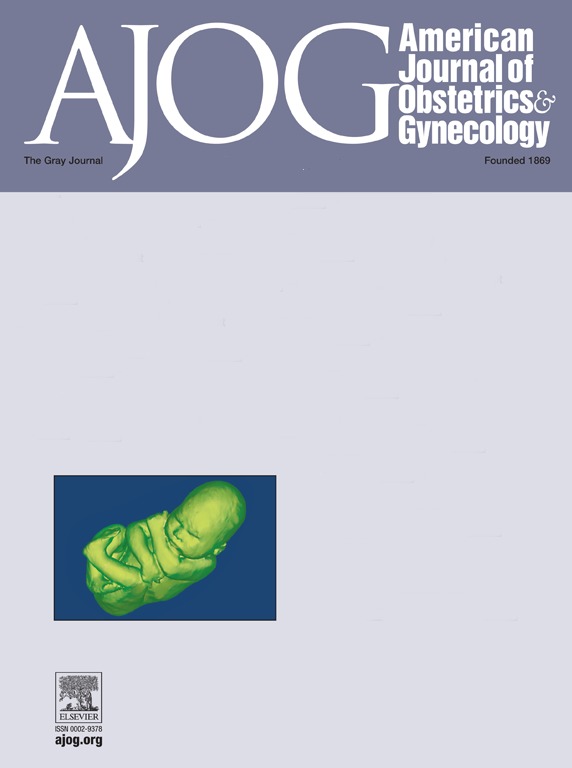Effectiveness and safety of assisted vaginal birth and second stage caesarean section: a systematic review and meta-analysis of real-world contemporary data.
IF 8.4
1区 医学
Q1 OBSTETRICS & GYNECOLOGY
引用次数: 0
Abstract
OBJECTIVE To synthesize evidence on the effectiveness of different instruments for assisted vaginal birth (AVB) and to assess the prevalence of maternal and neonatal adverse outcomes associated with AVB and second-stage cesarean section (SCS). DATA SOURCES A comprehensive search was conducted in Cochrane, Embase, and MEDLINE to identify randomized controlled trials, cross-sectional, and cohort studies published between January 2001 and December 2023. STUDY ELIGIBILITY CRITERIA Studies published in English, Spanish, French, or Italian with >30 participants, conducted in any type of healthcare facility, and reporting operative procedures in the second stage of labor were eligible if they included at least one outcome of interest for women undergoing AVB and/or SCS. STUDY APPRAISAL AND SYNTHESIS METHODS Two independent reviewers conducted study selection, data extraction, and quality assessment. Meta-analyses of proportions were performed using random-effects models, and heterogeneity was assessed using the I2 statistic. RESULTS A total of 241 studies, involving 751,242 participants, were included, of which 231 were observational and 10 randomized controlled trials (RCT). Prevalence estimates for AVB failure and adverse outcomes varied widely. Vacuum extraction (VE) had a significantly higher failure rate than forceps (7.60% vs. 3.26%, p<0.01), but a lower prevalence of obstetric anal sphincter injury (4.73% vs. 7.99%, p<0.01). Spatula use was associated with a lower prevalence of neonatal cephalohematoma compared to VE (0.73% vs. 5.45%, p<0.01) and forceps (0.73% vs. 3.54%, p<0.01), but a higher prevalence of postpartum hemorrhage compared to VE (10.77% vs. 5.46%, p<0.0001). Compared to AVB, SCS was associated with significantly higher rates of NICU admission (17.18% vs. 6.64% forceps, 6.07% VE, p<0.001), low Apgar scores (6.01% vs. 2.43% forceps, 2.05% VE, p<0.01), skull fractures (1.54% vs. 0.27% for both, p<0.05), and neonatal death (1.95% vs. 0.31% for both, p<0.01). CONCLUSION Contemporary data reveal wide variability in the prevalence of failed AVB and adverse maternal and neonatal outcomes following operative delivery in the second stage of labor. While AVB carries specific risks, it may offer advantages over emergency SCS, particularly regarding neonatal outcomes.辅助阴道分娩和第二阶段剖宫产的有效性和安全性:对现实世界当代数据的系统回顾和荟萃分析。
目的综合不同辅助阴道分娩器械的有效性,评估辅助阴道分娩与二期剖宫产(SCS)相关的孕产妇和新生儿不良结局的发生率。资料来源在Cochrane、Embase和MEDLINE中进行了全面检索,以确定2001年1月至2023年12月间发表的随机对照试验、横断面和队列研究。研究资格标准:在任何类型的医疗机构中,以英语、西班牙语、法语或意大利语发表的、有bb30名参与者的研究,报告了分娩第二阶段的手术过程,如果研究至少包括一个对接受AVB和/或SCS的妇女感兴趣的结局,则符合条件。研究评价和综合方法由两名独立的审稿人进行研究选择、数据提取和质量评估。采用随机效应模型对比例进行meta分析,采用I2统计量评估异质性。结果共纳入241项研究,涉及751,242名受试者,其中观察性试验231项,随机对照试验10项。AVB失败和不良后果的患病率估计差异很大。真空拔管失败率明显高于产钳(7.60% vs. 3.26%, p<0.01),但产科肛门括约肌损伤发生率较产钳低(4.73% vs. 7.99%, p<0.01)。与VE相比,使用抹刀的新生儿头血肿患病率较低(0.73% vs. 5.45%, p<0.01),使用产钳的新生儿头血肿患病率较低(0.73% vs. 3.54%, p<0.01),但与VE相比,使用抹刀的产后出血患病率较高(10.77% vs. 5.46%, p<0.0001)。与AVB相比,SCS与NICU入院率(17.18% vs. 6.64%, VE 6.07%, p<0.001)、低Apgar评分(6.01% vs. 2.43%, VE 2.05%, p<0.01)、颅骨骨折(1.54% vs. 0.27%, p<0.05)和新生儿死亡(1.95% vs. 0.31%, p<0.01)相关。结论:当代数据显示,在第二产程手术分娩后,AVB失败的患病率和不良的孕产妇和新生儿结局存在很大的差异。虽然AVB具有特定的风险,但它可能比紧急SCS更具优势,特别是在新生儿结局方面。
本文章由计算机程序翻译,如有差异,请以英文原文为准。
求助全文
约1分钟内获得全文
求助全文
来源期刊
CiteScore
15.90
自引率
7.10%
发文量
2237
审稿时长
47 days
期刊介绍:
The American Journal of Obstetrics and Gynecology, known as "The Gray Journal," covers the entire spectrum of Obstetrics and Gynecology. It aims to publish original research (clinical and translational), reviews, opinions, video clips, podcasts, and interviews that contribute to understanding health and disease and have the potential to impact the practice of women's healthcare.
Focus Areas:
Diagnosis, Treatment, Prediction, and Prevention: The journal focuses on research related to the diagnosis, treatment, prediction, and prevention of obstetrical and gynecological disorders.
Biology of Reproduction: AJOG publishes work on the biology of reproduction, including studies on reproductive physiology and mechanisms of obstetrical and gynecological diseases.
Content Types:
Original Research: Clinical and translational research articles.
Reviews: Comprehensive reviews providing insights into various aspects of obstetrics and gynecology.
Opinions: Perspectives and opinions on important topics in the field.
Multimedia Content: Video clips, podcasts, and interviews.
Peer Review Process:
All submissions undergo a rigorous peer review process to ensure quality and relevance to the field of obstetrics and gynecology.

 求助内容:
求助内容: 应助结果提醒方式:
应助结果提醒方式:


